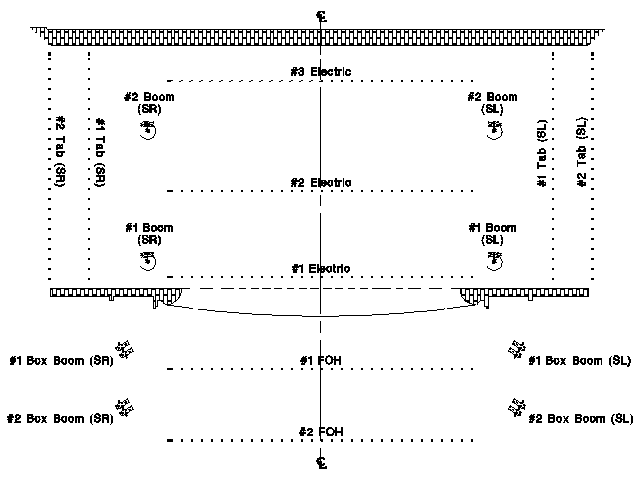Proscenium Stages:
|
 Position Names:
Position Names:
- Positions which run the width of the stage and are upstage of the proscenium are
usually called "electrics." If these are not pipes, but fully-accessible hanging positions with
catwalks for the electricians to walk upon, they may be called "bridges".
- Positions which run the width of the stage and are downstage of the proscenium arch
are called "FOH" (for "front-of-house") positions. In some theatres,
these are referred to as "coves" or "cats" (for "catwalks"), and in Europe, these,
too, may be referred to as "bridges".
- Positions which run from DS to US (or, depending on your point of view, US to DS) and are upstage of the proscenium arch
are called "tabs".
 Vertical pipes are, in general, called "booms".
Booms which are downstage of the
Proscenium are referred to as "box booms" (because they were, originally,
located in the "opera boxes" on either side of the stage. In some theatres, these positions, Vertical pipes are, in general, called "booms".
Booms which are downstage of the
Proscenium are referred to as "box booms" (because they were, originally,
located in the "opera boxes" on either side of the stage. In some theatres, these positions,
 too, are called, "coves". Another form of vertical position is the "Ladder"
(two examples pictured).
too, are called, "coves". Another form of vertical position is the "Ladder"
(two examples pictured).
- Many theatres have balconies with rails that can be used for hanging
lighting fixtures; these are called, appropriately, "balcony rail" positions.
- In addition to pipes, bridges, and various catwalks, hanging positions can be
triangular or square trusses; when these are vertical, they are called "columns".
Position Numbers:
- Electrics, booms, box booms, and FOH positions are typically
numbered from the proscenium out. For example, the downstage-most
electric (the one closest to the proscenium) would be the "#1
Electric" (or "1E") and the electric just upstage or it (the second-closest
to the proscenium) would be the "#2 Electric," etc.
Likewise, the upstage-most FOH position (closest to the proscenium)
would be the "#1 FOH" (or "FOH #1"), while the position just
downstage of it would be the "#2 FOH", etc.
- Tab electrics are usually numbered from centerline out. On stage left,
the tab closest to centerline is the "#1 Tab SL"; likewise, on
stage right, the tab closest to centerline is the "#1 Tab SR".
There are many variants of this system and you will usually find your show
served best by your adapting whenever possible to whatever system is in
place and already understood by the electricians who work in whichever
theatre you're playing.
| |
Arena and Thrust Stages:
|
The systems used to describe and number the hanging positions over
arena and thrust stages vary even more than do those in proscenium
theatres, largely because there is greater variety among them. This is an
example of a typical arena or thrust grid:
 You will certainly find hanging positions which differ greatly from
those described on this site, and frequently you will have to
devise your own numbering and naming schemes. It is important that when
you do so, you make your system clear and as easy as possible for the electricians
to understand.
Remember: if you really want to put a light in a specific place,
even if there's no position there in the theater, you can generally
find a way to do it - though that might turn out to be too expensive
or time consuming. Don't design your lighting thinking, "OK there's a
pipe so I'll put a light there"; think of what light you want to send
to the stage, and from what angle, and if there isn't a ready-made position
in that precise location,
there's probably a way to rig one.
You will certainly find hanging positions which differ greatly from
those described on this site, and frequently you will have to
devise your own numbering and naming schemes. It is important that when
you do so, you make your system clear and as easy as possible for the electricians
to understand.
Remember: if you really want to put a light in a specific place,
even if there's no position there in the theater, you can generally
find a way to do it - though that might turn out to be too expensive
or time consuming. Don't design your lighting thinking, "OK there's a
pipe so I'll put a light there"; think of what light you want to send
to the stage, and from what angle, and if there isn't a ready-made position
in that precise location,
there's probably a way to rig one.
| |